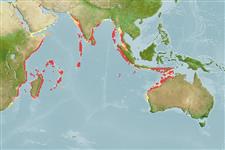Issue
Emily Repair country records.
Environment: milieu / climate zone / depth range / distribution range
Écologie
marin; saumâtre récifal. Tropical
Western Indian Ocean: Mozambique, Mauritius, Reunion (Ref. 54356), and Seychelles. Probably more wide-ranging in the area. Western Central Pacific: Guam (Ref. 35720) and Australia (Ref. 2334).
Length at first maturity / Taille / Poids / Âge
Maturity: Lm 35.0 range ? - ? cm
Max length : 60.0 cm SL mâle / non sexé; (Ref. 37792); âge max. reporté: 25 années (Ref. 52229)
Épines dorsales (Total) : 5; Rayons mous dorsaux (Total) : 26 - 29; Épines anales: 2; Rayons mous anaux: 26 - 28. Small blackish spots usually present, at least dorsoanteriorly on body. Adults with a large bulbous protuberance at front of snout (Ref 9808).
Occurs in coral reefs. Diet consisted a high proportion of the green alga, Caulerpa.
Life cycle and mating behavior
Maturité | Reproduction | Frai | Œufs | Fécondité | Larves
Randall, J.E., 2001. Surgeonfishes of Hawai'i and the world.. Mutual Publishing and Bishop Museum Press, Hawai'i. 123 p. (Ref. 37792)
Statut dans la liste rouge de l'IUCN (Ref. 130435: Version 2024-1)
Menace pour l'homme
Harmless
Utilisations par l'homme
Outils
Articles particuliers
Télécharger en XML
Sources Internet
Estimates based on models
Preferred temperature (Ref.
123201): 24.5 - 29, mean 27.5 °C (based on 294 cells).
Phylogenetic diversity index (Ref.
82804): PD
50 = 0.5000 [Uniqueness, from 0.5 = low to 2.0 = high].
Bayesian length-weight: a=0.02089 (0.00974 - 0.04480), b=2.96 (2.78 - 3.14), in cm total length, based on LWR estimates for this Genus-body shape (Ref.
93245).
Niveau trophique (Ref.
69278): 2.0 ±0.00 se; based on food items.
Generation time: 2.6 ( na - na) years. Estimated as median ln(3)/K based on 1
growth studies.
Résilience (Ref.
120179): Faible, temps minimum de doublement de population : 4,5 à 14 années (tm=4; K=0.428; tmax=25).
Fishing Vulnerability (Ref.
59153): Low to moderate vulnerability (33 of 100).
Nutrients (Ref.
124155): Calcium = 37.1 [21.6, 74.3] mg/100g; Iron = 0.587 [0.284, 1.028] mg/100g; Protein = 19 [18, 20] %; Omega3 = 0.138 [0.084, 0.262] g/100g; Selenium = 40.8 [20.9, 80.9] μg/100g; VitaminA = 36.2 [10.4, 119.7] μg/100g; Zinc = 1.59 [1.07, 2.32] mg/100g (wet weight);
